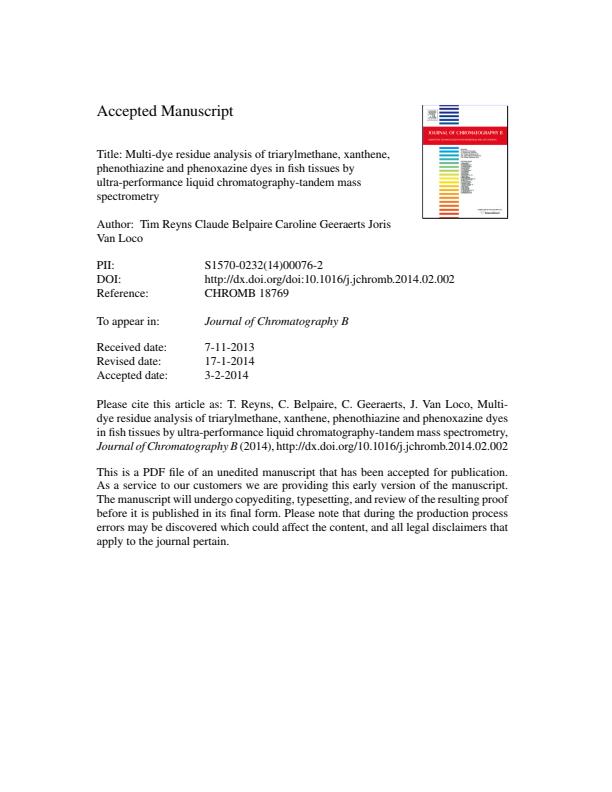Multi-dye residue analysis of triarylmethane, xanthene, phenothiazine and phenoxazine dyes in fish tissues by ultra-performance liquid chromatography-tandem mass spectrometry
Details
| Number of pages | 10 |
|---|---|
| Volume | 953-954 |
| Pages (to-from) | 92-101 |
| Type | A1: Web of Science-article |
| Category | Research |
| Magazine | Journal of chromatography. B, Analytical technologies in the biomedical and life sciences |
| Language | English |
Bibtex
@misc{87d38067-0d15-4aee-ac9e-22c1ecca2b5f,
title = "Multi-dye residue analysis of triarylmethane, xanthene, phenothiazine and phenoxazine dyes in fish tissues by ultra-performance liquid chromatography-tandem mass spectrometry",
abstract = "Beside the possible illegal use of malachite green in aquaculture, other familiar dyes could also been applied by fraudulent producers due to their antiseptic and antibacterial activity. In this contribution, a new sensitive multi-residue method was developed to determine triarylmethane, xanthene, phenothiazine and phenoxazine dyes in fish by ultra-performance liquid chromatography-tandem mass spectrometry. Samples were extracted with acetonitrile, followed by an oxidation step using 2,3-dichloro-5,6-dicyanobenzoquinone. Further clean-up was performed by tandem solid phase extraction using weak and strong cation exchange cartridges. Extracts were analysed by UPLC-MS(n) operating in the positive electrospray ionisation mode (ESI+). The fourteen dyes were separated within only 12min on a C18 BEH column using 1mM ammonium acetate in water at pH 4.5 and acetonitrile as mobile phases at a flowrate of 0.4mLmin(-1). The presented method was validated as defined by the European Union and scientific literature. Good linearity (R ≥0.99 and goodness-of-fit (g) ≤10%) was achieved over the tested concentration range (0.25-2ngg(-1)). Limit of quantification was 0.25ngg(-1) for all dyes, with a signal-to-noise ratio of at least 10/1. This is at least 5 to 10 times lower than previous published methods. Limits of detection were all ",
author = "Tim Reyns and Claude Belpaire and Caroline Geeraerts and Joris Van Loco",
year = "2014",
month = jan,
day = "01",
doi = "https://doi.org/10.1016/j.jchromb.2014.02.002",
language = "English",
publisher = "Instituut voor Natuur- en Bosonderzoek",
address = "Belgium,
type = "Other"
}

